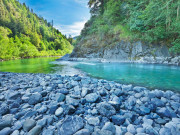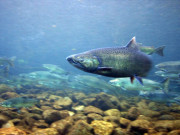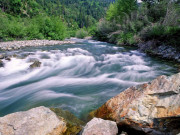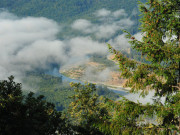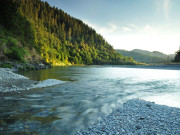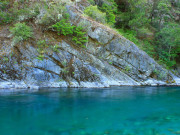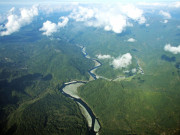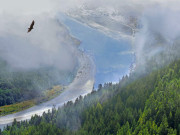(Editor’s note: Sue Doroff co-founded Western Rivers Conservancy and serves as president. Sue has more than 25 years of experience in conservation real estate, and her commitment to protecting our great western streams is guided by a lifelong passion for rivers and the outdoors. During her career Sue has purchased and protected tens of thousands of acres along dozens of rivers throughout the West.)
Our favorite tagline at Western Rivers Conservancy (WRC) is “Sometimes to save a river, you have to buy it.” It’s simple and speaks to the straightforwardness of what we do. We buy riverlands in order to save rivers. It is uncomplicated on the surface, but complex underneath, and the outcomes we seek are always the same: a river protected forever.
On the simplest level, two things are required to make our projects happen: a willing seller and a conservation partner that will take ownership of the land and manage it for the sake of fish, wildlife and people. Unlike traditional land trusts, WRC does not hold riverlands in perpetuity. We seek out a conservation steward to do that, such as the Bureau of Land Management, a university, the U.S. Forest Service or a tribal partner — an entity that possesses the resources, the infrastructure, and the interest to forever care for the lands that we buy in order to protect.
Lately, in our searches for the best long-term conservation partners, we’ve found ourselves turning increasingly to Indian Country. The most obvious example of this is our partnership with the Yurok Tribe in California to create a salmon sanctuary and tribal community forest on the Klamath River. In partnership with the Yurok, we are working to bring more than $60 million to the table, funding a historic project with a complex mix of public and private dollars, including New Markets Tax Credits (NMTCs). Thanks to this successful partnership, combined with guidance from Travois, NMTC dollars are now invigorating the Yurok economy while establishing a safety net for salmon and a tribal community forest, which the Yurok will manage for the sake of clean water, forest health, fish and wildlife habitat, and cultural rejuvenation.
Another recent and successful partnership was our work with the Confederated Tribes of Grand Ronde to conserve a critical stretch of Oregon’s North Santiam River. The North Santiam once produced a third of the Willamette basin’s spring chinook and an incredible two-thirds of its winter steelhead. Today, of course, those runs are imperiled. But because the tribe values these riverlands for the rich cultural and natural resources they harbor, we were able to conserve a portion of the best remaining habitat for salmon and steelhead within the entire Willamette River basin and North Santiam sub-basin.
We are also working with the Confederated Tribes of the Umatilla Indian Reservation to restore a critical reach of Oregon’s Catherine Creek, a tributary to the Grande Ronde and Snake rivers. Thanks to this partnership, the Umatilla will acquire important lands, and a key stretch of Catherine Creek will undergo major restoration. The reach of stream that flows through the property has been identified as some of the highest priority chinook habitat in the entire Columbia Basin. For the sake of salmon and steelhead, it’s an incredibly important project and one that relies on the Umatilla to complete.
For us, partnerships with Indian Country have become extremely effective. In a sense, they allow us to double our impact. They enable tribes to acquire culturally important lands that will invigorate their economies and expand tribal landholdings, while allowing WRC to achieve its mission of protecting the West’s most outstanding rivers. But in the end, these are partnerships for our rivers — and our rivers will thank us. They’ll thank us with healthier runs of chinook and steelhead, as havens for wildlife, and as special places to which we can return for respite, where we can revive ourselves in the company of critters, trees and moving water.
For more information about WRC, visit www.westernrivers.org.
(Photos are copyrighted by: Dave Jensen (1,6,8), Thomas Dunklin (2,7), Rick Hiser (3,5), Peter Marbach (4). Images may not be reused or modified.)



